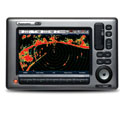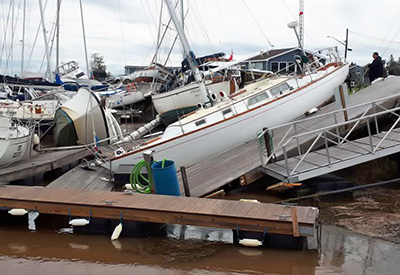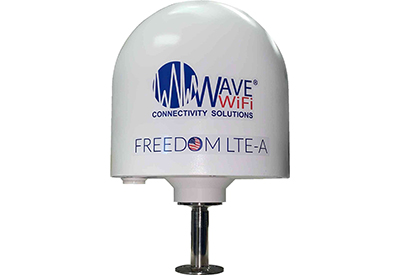Canadian Yachting Marine Electronics Gear Guide
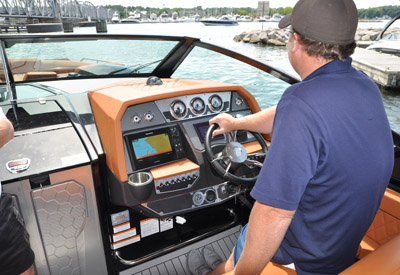
Hot new products for 2019
By Craig Ritchie
While the basics of boat hull design hasn’t changed that much over the years, the same cannot be said for marine electronics. Indeed, the explosive growth in this market has changed the way we go boating and it continues to do so at an accelerated pace. Where a fish finder or a chartplotter was once considered high-tech, today’s yachts may include fully digital helms with huge crystal-clear touch-screen displays presenting data from extremely sophisticated sonars, radar with Doppler technology, improved autopilots, night vision cameras, and more – all controlled with those familiar pinches and swipes we use every day on our smartphones.
The revolution isn’t just at the helm, either. New marine audio systems deliver concert hall sound over Wi-Fi networks, streaming wirelessly from the phone in your pocket. Stay in touch with loved ones over global satellite telephone networks, check your email, or stream the latest Hollywood blockbuster on Netflix while you’re miles from shore, if that’s what you like.
Electronics let us monitor our boats from anywhere on the planet, and some will even send you a text to let you know they turned on the bilge pumps to deal with runoff from the overnight thunderstorm.
Each year the leading manufacturers present their latest and greatest innovations at two key industry trade shows – NMEA, held in late September, and IBEX, held a week later. Canadian Yachting was there, and we’re pleased to present some eye-opening highlights from the class of 2019.
 Fusion Apollo RA 770 (Left)
Fusion Apollo RA 770 (Left) Infinity Kappa (Right)
Infinity Kappa (Right)
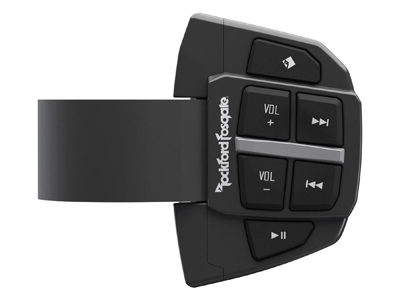 Rockford Fosgate
Rockford Fosgate
AUDIO
Who doesn’t like to listen to music out on the water? Whether your tastes run to classical or country or old-time rock n’ roll, you’ll probably enjoy Clarion’s new CMS4, which features 280 watts of power for driving bass notes and ringing highs. Choose audio from four multimedia source zones, each with independent zone volume control, controlled by most popular multi-function displays through the NMEA2000 network.
The all-new Fusion Apollo RA770 raises the bar on audio quality as the first marine stereo in the world to offer Wi-Fi streaming from handheld devices. Wi-Fi is said to deliver measurably better sound quality over Bluetooth streaming technology without clipping high and low frequencies. Digital signal processing technology provides exceptional audio fidelity, while the optically bonded, full-colour LCD touchscreen displays offer intuitive operation with familiar smartphone-like gestures, and a standard volume knob provides immediate volume control without scrolling. Or, just control it remotely with Fusion’s app.
The Infinity by Harman Kappa eight-inch speaker is said to be the first three-way marine speaker with a removable mid-tweeter. Most stereo speakers in boats are installed at knee level, a height lower than optimal for peak sound quality. The ability to remove the mid-tweeter and easily reposition it at ear height using a dedicated adaptor ring allows boaters to position the tweeter where higher frequencies are best enjoyed for greater sound quality – and without having to reroute any wiring.
The PMX-SYS1 compact digital media receiver from Rockford Fosgate features a
full dot matrix LCD Gorilla display, independent subwoofer level control, Bluetooth wireless streaming, and an AM/FM/WB tuner. There’s also a seven-band graphic equalizer, as well as separate AUX and USB inputs with USB charging capability. Best of all, the entire system operates from a compact remote control that can be strapped to any existing steering wheel.
Cartography
Digital charts were once a novelty – today they deliver capabilities and features that old paper charts just can’t match. C-MAP’s updated MAX-N+ and Insight HD maps, for example, incorporate high-resolution satellite imagery, aerial photographs, 3D views, high-resolution bathymetric fishing charts, detailed marina charts, and dynamic raster charts for what the company describes as “an unparalleled navigational experience”. C-MAP’s MAX-N+ provides coastal charts for most of North America, while Insight HD provides extensive coverage of freshwater inland lakes and rivers.
Humminbird’s new LakeMaster charts feature easy-to-read contours, highlighted depth ranges, and scrollable lake lists for quick and easy operation. The Humminbird LakeMaster library includes more than 10,000 lakes spread across North America, including two new regional micro cards for the Great Lakes region and Ontario.
Navionics users will enjoy the new Navionics+ Regions charts, which leverage the largest cartography database in the world to provide coverage of more than 22,000 lakes and rivers throughout Canada and the U.S. The cartography works with most MFD brands, displayed in the user’s choice of traditional nautical chart or as a SonarChart with one-foot contours. The product also integrates user-generated content for exceptional local detail.
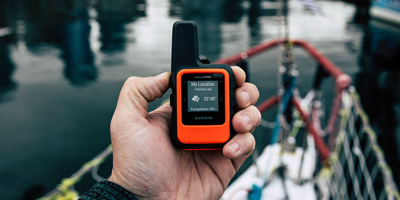 Garmin InReach Mini
Garmin InReach Mini
Connectivity
Staying in touch around the world is easy with Garmin’s palm-sized inReach Mini satellite communicator. The device provides two-way messaging and interactive SOS, plus basic navigation, over the global Iridium network. Online location tracking with the Earthmate app allows users to share their whereabouts with friends or loved ones at home, while optional weather forecasts help prepare for what lies ahead.
Intellian’s FB150 offers simultaneous access to voice, SMS, and data anywhere in the world. Multi-voice capability allows up to four separate phone calls to be made simultaneously, while delivering exceptional audio quality using the Inmarsat network.
Staying in touch has never been easier thanks to KVH’s all-new TracPhone V7, which offers enhanced global coverage on a next-generation HTS network. The compact unit is offered with a variety of data plans, including a high-speed channel that supports 10/3 Mbps upload/download speeds for streaming data, and an unlimited-use channel for heavy data users.
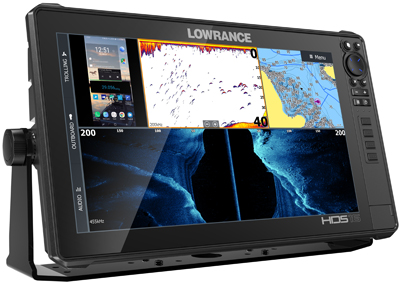 Lowrance HDS Live Left
Lowrance HDS Live Left
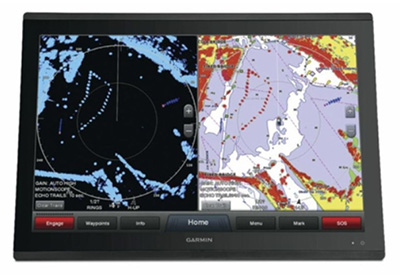 Garmin GMR Fantom Right
Garmin GMR Fantom Right
Multi-Function Displays
Electronics manufacturers continue to deliver incredible advances in multi-function screens, offering greater clarity, improved graphics, and intuitive operation.
Garmin’s GPSMAP 8624 features a massive 24-inch high definition touch screen that is said to currently offer the highest resolution on the market. A high-speed processor provides fast map drawing, while network presets for sonar, radar, cameras, media, and digital switching allow the screen to operate independently or be incorporated into Smart-Mode station controls. Connectivity is assured with built-in Bluetooth and Wi-Fi; it also features NMEA 2000, HDMI, USB, and Ethernet connections as well as FUSION-Link integration. It’s also fully compatible with Garmin’s Active Captain app.
While its SOLIX 15 CHIRP MEGA SI GPS name is definitely a mouthful, Humminbird’s all-new touchscreen claims to be the first fish finder operating in the megahertz range. With its CHIRP technology and high power, it delivers exceptionally clear underwater views with improved detail and target separation. Its fully customizable 15.4-inch screen – controlled either directly or via a keypad – provides up to four viewing panes.
Lowrance greets 2019 with its all-new HDS LIVE flagship MFD, offering real-time three-in-one sonar with Lowrance CHIRP, SideScan and DownScan Imaging, charting, and a broad range of connectivity features including LiveCast smartphone integration. It’s available in 7-, 9-, 12- and 16-inch display sizes.
Also new from Lowrance is its Elite Ti2, available in 7-, 9-, and 12-inch display sizes. Delivering enhanced high-resolution sonar functionality and wireless networking, the Elite Ti2 features CHIRP, SideScan and DownScan imaging, Bluetooth calling, and text notifications.
The NSO evo3 from Simrad features an ultra-bright, ultra-clear 19-inch display that’s viewable from any angle without blacking out, even when wearing polarized sunglasses. Features include an integrated quad-core processor for instant data access, and low-profile glass helm styling that complements any décor.
Raymarine’s Axiom 16 Pro RVX is powered by a blazingly fast quad core processor that works in concert with the LightHouse 3 OS with IPS display technology to make the most of its full 1920 x 1080 high-definition screen. Instantaneous response from its built-in one kW RealVision 3D CHIRP sonar gives boaters an amazing amount of information in full high-definition, while intuitive operation and classic styling suit a variety of helm designs.
Navigation
By far the biggest news in navigational electronics for 2019 comes in the form of new autopilots and Doppler radar sets. Axiom’s Quantum 2 radar with Doppler technology displays approaching targets in red and targets moving away from your position in green, to quickly identify potential collision threats at a glance. Fully automatic MARPA target tracking and True Trails target history makes it easy to monitor the speed and bearing of surrounding traffic for a clear view of potential hazards.
B&G’s all-new Triton 2 autopilot stands out with its contemporary styling around a full-colour display that fits with modern glass helm designs. Installed with a Triton 2 Pilot Controller keypad, the unit displays speed, water depth, wind speed and direction, engine data, and more.
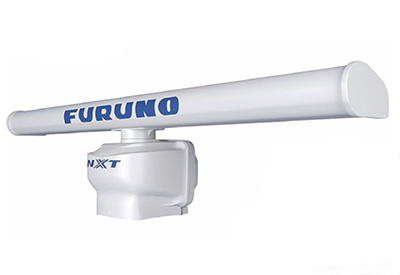 Furuno radar DRS6A NST (Left)
Furuno radar DRS6A NST (Left)
 Garmin GMR Fantom (Right)
Garmin GMR Fantom (Right)
The DRS6A-NXT radar set from Furuno features solid state Doppler tracking that can monitor up to 100 moving targets simultaneously, displaying them in different colours to identify those representing the greatest collision threat. Stationary or slow-moving targets are displayed in green, while those converging at a speed of more than three knots are highlighted in red.
Also new from Furuno is the company’s NavPilot 300 autopilot, designed with small to mid-sized outboard-powered vessels using drive-by-wire systems in mind. It uses gesture control technology that makes it easy to set headings with its handheld Gesture Controller – simply press a button, point to the desired direction, and release the button to control the boat’s steering from anywhere onboard within 30 feet of the helm. A Sabiki mode functions as a virtual anchor, useful for holding the boat in position when waiting to enter a lock or pass a lift bridge.
Garmin’s GMR Fantom 24 dome radar also benefits from Doppler technology, displaying its targets in different colours to identify threats at a glance with its integral MotionScope technology. Instant power-on eliminates the need to warm up prior to operation, while dynamic automatic gain control and MARPA functionality allow the Fantom 24 to track up to 10 targets simultaneously, at ranges from as close as 20 feet to as far as 48 nautical miles.
Garmin’s GHP Reactor 40 autopilot incorporates a nine-axis Attitude Heading Reference System that is said to provide more accurate vessel control with reliable heading accuracy to within two degrees in all sea conditions. Flexible mounting options and quick, easy commissioning make installation simpler. Shadow Drive technology automatically disengages the autopilot when the operator takes control of the helm, and automatically re-engages once a steady heading is established.
Lowrance was the first manufacturer to use beam sharpening technology in its broadband 4G radar, providing an exceptionally sharp image display for improved target resolution – users can simply change the width of the radar beam to control the level of target separation as required. The technology allows 4G radar sets the unique ability of simultaneously displaying multiple targets at ranges from 200 feet to 36 nautical miles. Fast scan speeds provide near-instant updates of position changes for targets located at ranges of less than one nautical mile.
 Simrad Halo24 (Left)
Simrad Halo24 (Left)
 Raymarine Cam 220IP (Right)
Raymarine Cam 220IP (Right)
The Halo24 pulse compression radar from Simrad boasts 60 rpm high-speed rotation at distances up to 1.5 miles for increased safety and improved performance. Delivering a full 360-degree sweep every second, this extremely fast refresh rate gives users an almost real-time view at close range. Offering short-, mid- and long-range detection capability, Halo24 is designed to process multiple ranges simultaneously for instantaneous dual range performance.
VelocityTrack Doppler technology provides instant visual feedback on the motion of radar targets in relation to the boat, as well as MARPA functionality to increase situational awareness and decrease the risk of collision.
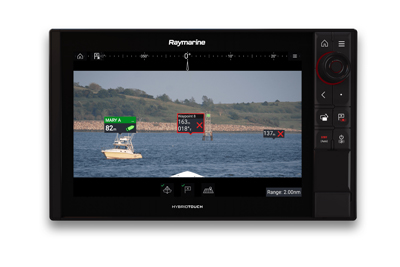 Raymarine Clear Cruise
Raymarine Clear Cruise
Raymarine greets 2019 with its breakthrough ClearCruise Augmented Reality (AR) system, which it says is an industry-first navigation technology that brings augmented reality to the company’s Axiom multifunction displays. Using HD video and advanced image stabilization technology, Raymarine’s ClearCruise AR helps captains make smarter and faster navigation decisions with visual overlays of nearby navigation aids, AIS traffic, and destination waypoints. The system works by blending high-definition digital video from networked marine cameras with dynamic graphics that identify and call attention to AIS contacts, navigation chart objects, and waypoints. The augmented reality display updates in real-time and the image is digitally stabilized by the AHRS sensor to compensate for maneuvering and sea conditions.
Remote Monitoring
One of the fastest-growing categories in marine electronics is remote monitoring, giving boaters the ability to keep tabs on their boat from anywhere in the world.
GOST’s new Mini Dome PTZ 1080P AHD is a discreet, tamper-proof, two-megapixel camera that allows boaters to keep an eye on the boat – literally – using the company’s remote GOST WATCH system. The camera uses a high-quality lens with four-times optical zoom function for clear, high-resolution images in 1080p.
![]() NauticOn 1
NauticOn 1
Mercury Marine’s new Nautic-On remote monitoring app provides a range of advanced functions for boaters using compatible Mercury engines and controls. Features include GPS tracking and GeoFence functionality so you can keep track of where the kids go with the boat, remote battery monitoring to warn against low power levels, and bilge pump monitoring to guard against accidental flooding. Engine status monitoring allows owners to keep track of critical operating data in real-time, including oil pressure, water pressure, engine hours, and more. There’s even a weather channel to warn of inclement conditions beyond the horizon.
Nautic Alert X2 offers a unique bilge management system that detects leaks and can automatically switch on bilge pumps and display events and data remotely. Additional features include advanced anti-theft capabilities, monitored SAR/MOB utility, multi-bank monitoring, and more.
Raymarine’s CAM220IP ultra-compact CCTV camera delivers high-quality, high-definition images day or night. Ideal for use below decks, in engine rooms, or above decks, the camera records either still or digital video images. When combined with a Raymarine LightHouse 2 or 3 MFD, it can even double as a back-up camera to facilitate docking.



